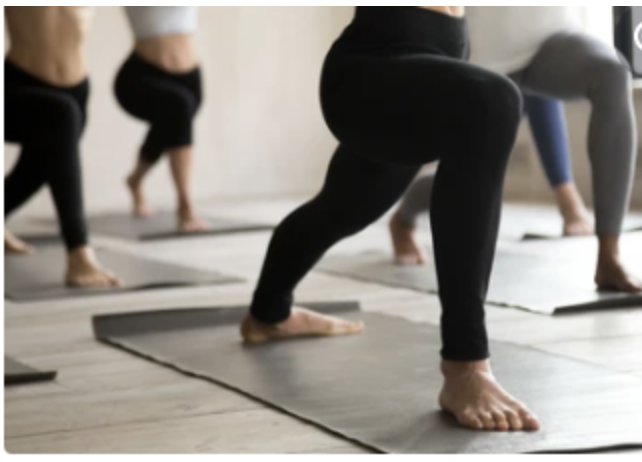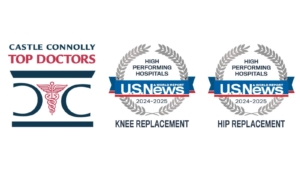Slippery Pants and Other Patient-to-Patient Advice for Total Hip Replacement
There was never an iota of doubt in my mind that Dr. William Leone at the Leone Center for Orthopedic Care at Holy Cross Health was the surgeon I would turn to if I needed a total hip replacement last summer. His reputation among doctors, nurses and hospital staff speaks volumes about his excellent results, and in addition to all the praise for his professionalism, his patients seem to adore him! His office staff, RNs and PAs are in perfect synch with the friendly, reassuring and patient-centered vibe of his office. Nonetheless, I put off scheduling surgery and opted instead for several months of self-directed physical therapy and an injection, illogically convinced that I could get rid of the pain myself. I was wrong, which brings me to the first piece of unsolicited advice I’d offer anyone in a similar situation: Stop the wishful thinking and schedule the surgery.
The problem with wishful thinking is that it makes things worse. If you’re like me, you’ll deny that you need surgery until you can’t deny it anymore. I tried a diligent regimen of physical therapy as well as an injection for the pain, but neither worked. It was a painful lesson as I came to grips with the reality that I I had no choice. Dr. Leone, a respected surgeon, had evaluated my situation and told me that I needed surgery, but I chose wishful thinking instead. When I finally accepted the inevitability of surgery, the pain had become progressively so excruciating that I was counting down the hours until I could have the operation and the pain might go away, which it did.
As I left the hospital and got into the car, I realized that it was the first time in weeks I was not in pain. Sure, there was some discomfort when the anesthesia wore off and during the following week, but it was just mild discomfort and nothing even remotely similar to the pain I experienced before surgery.
Dr. Leone clearly believes that a well-informed patient is likely to have fewer hurdles and better outcomes than one who doesn’t take the time to get informed, and I couldn’t agree more. I left the pre-op consult with a blue information folder and brochure so chock full of patient-friendly information that, after reading it carefully several times and highlighting some important instructions, I kept it nearby on my dresser for weeks and consulted it often. That being said, there were a couple of unexpected challenges outside the realm of medicine that popped up during the weeks of recovery … like why it’s a good idea to wear slippery pants.
One of the toughest things of all in the two weeks following surgery was getting my operated right leg into bed or onto the sofa. The first few days I could barely lift it at all, let alone lift it straight up first and then laterally onto the bed. The home health physical therapist taught me a couple of little tricks that helped. She had me hook my left leg under my right, breathe out, and pull my legs onto the sofa together, the left one lifting the right. Another helpful option was looping a belt around my legs like a lasso and pulling it up and over, which just goes to show that there’s always a solution if you think creatively enough to find it!
The next part of the move was getting my whole body to the center of the bed or sofa and straightening out, which was very difficult when my clothes were cotton and didn’t slide. It may sound crazy, but it happened multiple times each day as I tried to elevate my legs and was one of the most frustrating and uncomfortable parts of the recovery process. My takeaway is this: Soft sweats may be comfortable, but they make it very rough to slide, move and get settled. Wearing something slippery or using a satin sheet was my solution, which you, too, may find helpful. So consider having some slippery nylon, silk or satin clothes on hand to help you glide into place.
It’s harder than you may imagine lifting your leg into the leg of your pants or folding over to put on your shoes in the days after surgery, so here’s my recommendation: Prior to surgery, set aside clothes that are easy to put on, such as pants with baggy legs, skirts and slip-on shoes. While it is easier to get dressed if someone is home to help, you also can do it on your own. You’ll need clothes and shoes that are easy to get into, a strategic decision about where to sit and how to position yourself for safety and comfort, and an extra dash of patience.
Another what-to-wear tip for anyone who likes tight-fitting leggings is that they are great for holding ice packs in place while you’re sitting or lying down.
So plan accordingly and don’t let frustration get the best of you. You’ll have some trouble getting in and out of bed. You’ll slam your derriere onto the toilet seat while standing up or sitting down, and it hurts. Your ankles will swell if you sit too long. You’ll drop something and won’t be able to pick it up, but don’t despair. If you can’t get up off the toilet seat without reaching for the towel bar and risking pulling it out of the wall, you can place one hand on the front of the seat, one on the back and use your arm strength to push yourself up. The good news is that you’re noticeably stronger every day and the best news is that the hip pain is gone!
In a nutshell, from one who has had a successful total hip replacement to others who might: Don’t let wishful thinking shape your decision-making. Your osteoarthritic hip is not likely to heal itself, even if you exercise religiously. Procrastination is not your friend. Focus on coming up with solutions to the challenges you face during the recovery process rather than dwelling on the problems. Don’t get frustrated by your helplessness. Buy the grabbers, sock gizmos, toilet risers and other gadgets that are designed to help you as you recover — including those slippery satin pants – and everything will be okay.





